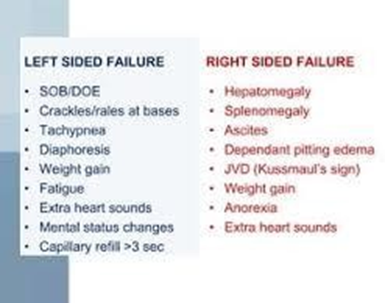The nurse is caring for a client after a coronary artery bypass graft surgery. The client is exhibiting pitting edema of the lower extremities and jugular venous distention with increased central venous pressure. Which condition should the nurse suspect the client is experiencing based on these findings?
Internal bleeding.
Right-sided heart failure.
Cardiac tamponade.
Left ventricular dysfunction.
The Correct Answer is B
A. Internal bleeding may present with symptoms such as hypotension, tachycardia, and signs of blood loss, but it typically does not cause pitting edema or jugular venous distention.
B. Right-sided heart failure can cause systemic venous congestion, leading to pitting edema of the lower extremities and jugular venous distention due to increased central venous pressure.

C. Cardiac tamponade presents with Beck's triad (hypotension, distended neck veins, muffled heart sounds) and is typically more acute in onset compared to the gradual development of symptoms seen in right-sided heart failure.
D. Left ventricular dysfunction primarily causes symptoms of pulmonary congestion, such as dyspnea, orthopnea, and crackles, rather than pitting edema and jugular venous distention.
Nursing Test Bank
Naxlex Comprehensive Predictor Exams
Related Questions
Correct Answer is A
Explanation
A. Palpitations and shortness of breath are symptoms of thyrotoxicosis, indicating excessive thyroid hormone levels, which could result from an overdose of levothyroxine sodium.
B. Bradycardia and constipation are more indicative of hypothyroidism, which would suggest the need for an increase in levothyroxine dosage rather than a decrease.
C. Muscle cramping and dry, flushed skin are symptoms of hypothyroidism, which would suggest inadequate thyroid hormone replacement rather than excess.
D. Lethargy and lack of appetite are also symptoms of hypothyroidism, not hyperthyroidism, which would not typically result from an overdose of levothyroxine.
Correct Answer is D
Explanation
A. Using a large gauge IV catheter can increase the risk of bleeding in a thrombocytopenic patient.
B. Wrapping bruised areas with elastic bandage dressings is not recommended as wrapping bruised areas with elastic bandages can cause additional pressure and potentially worsen bruising or bleeding.
C. While dietary modifications may be necessary for other reasons, removing cold and frozen foods does not address the immediate risk of bleeding associated with low platelet counts.
D. This is crucial because patients with thrombocytopenia are at an increased risk of bleeding, which may not always be visible or apparent. Regular monitoring can help in early detection and prompt management of any bleeding episodes.
Whether you are a student looking to ace your exams or a practicing nurse seeking to enhance your expertise , our nursing education contents will empower you with the confidence and competence to make a difference in the lives of patients and become a respected leader in the healthcare field.
Visit Naxlex, invest in your future and unlock endless possibilities with our unparalleled nursing education contents today
Report Wrong Answer on the Current Question
Do you disagree with the answer? If yes, what is your expected answer? Explain.
Kindly be descriptive with the issue you are facing.
